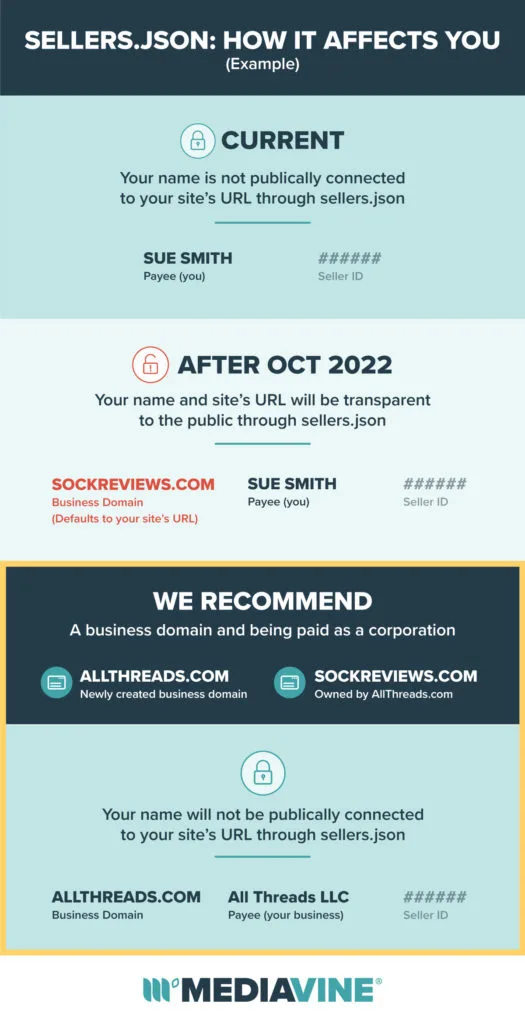Sellers.json Changes: Protecting Your Privacy


One of Mediavine’s core values as a business is transparency.
It’s what drives much of what we do internally and in the broader community. It leads us to be early adopters of efforts like sellers.json that are dedicated to transparency in the advertising ecosystem.
We’re also huge advocates of privacy.
This is why, when we first adopted sellers.json three-plus years ago, we did our best to protect our publishers’ identities by making business domains optional.
Industry standards (and interpretation of those standards) often evolve over time, however, and sellers.json is no exception. Recently, our ad partners have begun requiring that we publish a business domain.
Did I lose you yet? Most likely.
You’re probably wondering:
What the heck is sellers.json? What is a business domain, for that matter, and what does it have to do with privacy?
Let’s get some definitions out of the way first. I’ll try to keep this as brief, or as brief as a post written by me about sellers.json can be.
[Cracks knuckles, brews third cup of coffee …]
When we sell an ad spot on a publisher’s website, we’re considered part of the supply side – everyone from the publisher, to the ad management company (hi!), to the ad exchange and middle men or resellers that hop in are supply siders.
We are what advertisers, or the buy side in industry parlance, consider the sellers. Per the sellers.json standard, every person involved in the sale of an ad impression, except for the final payee (the publisher), must post what is called a sellers.json file.
This file lists every entity that we’re potentially selling on behalf of. It includes a seller ID, the name of the entity we’re paying and a business domain.
Transparency. By providing a seller ID with every impression sold — and assuming everyone in the supply chain does the same — a buyer can look up every actor involved.
This is extremely important in combating fraudulent activity and/or potentially unauthorized middlemen hopping in and reselling inventory.
So, this is the big change we’re talking about. Previously in the Mediavine’s sellers.json file, we only listed the seller ID and the payee name.
Going forward, we’re required to also list a business domain for each payee – this is the URL or website that represents your business.
In the case of a Mediavine-owned site like The Hollywood Gossip, we would list Mediavine.com as the business domain.
However, if a business doesn’t have a website for the corporation, as it were, or there is no corporation, then the name of the website that Mediavine represents in the digital advertising marketplace is the de facto business domain.
It depends. If you’re being paid as a corporation, likely nothing.
If you’re being paid as a person, it will depend on your situation. A lot of site owners have no problem listing their real name in the About Me section of their blogs.
From SEO benefits to building a rapport with audiences, there are various reasons to do this – but not everyone feels comfortable doing so.
Whether it’s out of concern for online safety, or for competitive reasons, or other factors, they don’t want their name on the website.
We understand both schools of thought, but this change impacts the latter.
Still with us? We appreciate it. If you’re confused at all, or just scrolling down in hopes that there’d be a TL;DR of sorts, it’s your lucky day:
Right now, if you’re a Mediavine publisher, you’re listed as a payee with sellers.json.
The name you’re being paid under via our payment provider, Tipalti, is listed with sellers.json – but only next to a random number, adrift in a sea of thousands of names.
Going forward, the payee (you) will also have to list a business domain. This will link you, the person, to your website name via sellers.json more directly than at present.
Basically, the payee can either be a person and the business domain can be your blog, OR the payee can be a business, with a separate business domain.
If you’re interested in protecting your personal privacy online, the first order of business is making sure you have a corporation set up.
We have to list a payee from the business domain, so Mediavine paying a company vs. a person offers an extra layer of protection.
The first step in the process is naming this new entity. I’d personally recommend something that isn’t simply the name of your website plus LLC or Inc. after it.
Using a more generic name makes it tougher for people to attach it to your website, while offering flexibility to expand or pivot the business as you grow.
(See: Mediavine, your friendly neighborhood SEO-for-hire startup turned internet publisher turned Ad Management company.)
Then you’ll actually have to go through the process of creating your new entity.
Sound daunting? The good news is we have a great guest blog post on how to set up an LLC.
After your corporation is set up, you’ll want to build your corporation’s website. This doesn’t have to be a fully optimized, SEO-friendly blog with a lot of content, but it should exist.
Seriously, you can even use a static hosted platform. Anything that allows you to set up a landing page is good enough for this task at hand.
Once you’ve completed these two steps, you can update that information with Mediavine.

While setting up the business is up to you, we’re making it incredibly easy to update your information with Mediavine in the coming weeks with a new modal.
The modal will prompt you for the changes. Fill it out when ready.
This process shouldn’t take long, but the sellers.json change won’t be live until October, and you’ll always be able to email Mediavine Support to make changes at any time.
We know this still feels like short notice, but we promise that we wouldn’t be acting with such urgency if it wasn’t an incredibly important ecosystem partner requesting this change.
Mediavine remains committed to transparency and privacy – but also to making sure our 9,000-plus publishers can build sustainable businesses.
Without this effort, that can’t happen. We hope the solutions we’ve offered above allow you to find that balance.
As always, please reach out to us with any questions.
Stay up to date with the latest from Mediavine
Welcome to the much-anticipated release of the fifth-annual edition of “The Best eCPM Days of the Year” calendar. Each year, we analyze historical trends to provide publishers with a graphical …
In today’s digital landscape, advertisers are becoming increasingly selective about where they place their ads. With the growing importance of brand safety, audience engagement and ROI, the quality of a …
 Eric Hochberger
Eric Hochberger
Since the advent of Trellis, Mediavine’s goal was to provide a WordPress framework to meet the needs and pain points of independent publishers. We’ve had the pleasure of working with …